
Delahaye 135 MS of the Agha Khan, the King of Kings. Fignoni & Falaschi, 1936.
Emile Delahaye was born in Tours in 1843 and had established a prosperous and eclectic industry there, ranging from brickyard machines and ceramic kilns to the first gas engines. A true pioneer of the automobile, he embarked on the adventure in 1894, producing two years later a first rear twin-cylinder model, two of which stood out during the Paris-Marseille race. But in 1898, Emile sold his company to Georges Morane and Léon Desmarais, which moved to Paris (XIIIth arrondissement) in 1901. From then on, focusing its production, reorganized by Charles Weiffenbach, on bi and 4 cylinders, the Société des automobiles Delahaye went give birth to many fairly classic models, with steel frames and removable cylinder head, which sell well, in particular the Type 32, a four-cylinder, from 1907 to 1913.
In 1911, while a complex V6 model was presented, Delahaye diversified its production, making trucks, agricultural machinery and especially fire fighting vehicles, which became its specialty. Delahaye mechanics, not very innovative, are on the other hand awarded for their reliability and their robustness, qualities appreciated abroad, which applies to certain models of being exported or produced under license in Europe or the USA. However, if Delahaye remains behind Renault or Citroën in terms of production, the main reason is essentially that their cars are more expensive. As a result, in 1927 the firm joined a group formed by Unic, Chenard & Walcker and Donnet with a view to regrouping the means of production and developing a common organ bank. Within this group, Delahaye loses all identity. It was in 1932 that the big change took place.
The big comeback, or rather the birth of the Delahaye myth, was born at the 1933 Paris Motor Show. Leaving the group and becoming autonomous again since 1932, Delahaye finally designed a luxury car with a 3.2-liter engine from a truck of the brand, a 90hp 6-cylinder called "138 superluxe". The offer is quickly supplemented by 4-cylinders of 2 and 3.8 liters. The following year, Delahaye bought Delage, in financial difficulties. The 138 will be available in a sports version, short chassis with 3 carburettors designed by Jean François. The latter won the Coupe des Alpes in 1935, transforming this victory into a surname for future models. The 6-cylinder Type 138 will serve as the basis for the excellent Type 135.
Type 135 is the one that makes the brand immortal more than any other. Its chassis is lowered, and the style is personalized and much more prestigious. It was in 1933 that the new inverted ogive grille was presented, a bit like Alfa-Romeo. The latter will later be adorned with functional "mustaches". The majority of the 135s were fitted from 1935 with a more sporty and modern Cotal gearbox at the steering wheel. These 135, which exist on several chassis, are mostly available in the form of very luxurious convertibles, with a wheelbase varying from 2.95 meters to 3 meters. Thanks to the competition versions with developed carburetors, the 135 won the Monte Carlo rally, the Paris-Nice, and we began to see special versions entered in the world championship and at Le Mans. Thanks to their good power-to-weight ratio, the avant-la-lettre GTs built by Delahaye are highly regarded in Europe. The high engine torque from their origin serves them tremendously.
The sporting achievements of the Delahaye 135 remained more than honorable in 1936. The Grand Prix of the automobile club of France, the ACF, which takes place in Montlhéry, welcomes prestigious GTs for its first edition. In front of the Bugatti 57, the 135MS (improved versions) won the first places. Then the feat was repeated at the Monte Carlo Rally of 1937 as well as in 1939, and finally the 24 hours of Le Mans 1938 where another 135MS was crowned. We also do not present the works passed to posterity in terms of the decorative flamboyance of the great French coachbuilders, then at the height of their international fame. These unique models, Delahaye producing naked chassis, find the most extravagant, the most outrageous dresses, which are still the delight of collectors and the amazement of the public during the elegance contests that they very often win, in particular that of Pebble Beach in California where they have their followers.
Alongside these cars of star and prince, very media, the "tourism" version deflated to 105hp is presented under the name of Delahaye 148L. More elitist are also the only V12 of the firm, the Delahaye 145, entered in GP and very lightened under the name of 155, and the 165 of luxury tourism. These are the most prestigious and expensive Delahaye ever produced, the 145 sport models developing up to 180hp and being able to f
Models
- Delahaye 138 MS Coupe des Alpes
- Delahaye 135M
- Delahaye 145S
- Delahaye 135MS 1948
- Delahaye 175
- Delahaye 235
Delahaye 138 MS Coupe des Alpes (1935)

135 M 1935: A classic among the classics.
2 + 2 seater roadster.
Front engine - rear transmission.
6 cylinders in line, 12 valves 3.2 Liters, 1 ACT, 120 hp DIN @ 4500RPM.
0-100 Km/h: 10 sec. ; 1000 D.A .:; Max speed: 170 Km/h.
1310 Kgs.
Length: 4180 mm; Width: mm; Height: mm; Wheelbase: 2900 mm
In 1934, Charles Weiffenbach, the owner of the brand, decided after a discussion which remained famous with Ettore Bugatti, to switch from the production of solid and heavy road cars to magnificent and brilliant GTs. Its first model was designed by Jean François, the new chief engineer, who developed the type 138. Its 3.2 6-cylinder engine then developed between 90 and 100hp. Then, with the victory in the Coupe des Alpes, the name went to these models, then to the new 135s which followed them with the takeover of Delage. The latter are lowered and equipped with a 6-cylinder 3.2L developing this time 110hp in "M" version with carburetors, while the basic version gives 100. A version with three 120hp (MS) carburettors is also making its appearance. The foolproof reliability and the acceleration of these engines give these convertibles an assertive sporty character. The competition version does not exceed a ton. A speed of 185 km/h observed for certain Figoni & Falaschi roadsters is truly exceptional in 1938. As for the luxury of most of these machines, we have hardly done better since.
Delahaye 135 MS (1948)

135 MS signed by the Swiss coachbuilder Ghia-Aigle

135 MS Signed Chapron
Roadster/Coach/Cabriolet 2 + 2/4 places.
Front engine - rear transmission.
6 cylinders in line, 12 valves 4 Liters, 1 ACT, 135 hp DIN @ 4500RPM. and N/M
0-100 Km / h: 11 sec. ; 1000 D.A .:; Max speed: 170 Km/h.
1880 Kgs.
Length: mm; Width: mm; Height: mm; Wheelbase: 3000 mm
By resuming the construction of the post-war 135, this best-seller, GT unanimously recognized and wonderfully dressed during the golden age of French bodywork, the 135MS with three carburettors developed from 135 to 145 hp depending on the version. But the heavy weight of their body compared to their ancestors of the 1930s placed them in the "Tourism-sport" category. They were replaced by the 235 with a slightly more powerful engine but still thickened by massive bodies and an archaic chassis.
Delahaye 235 (1950)

A convertible with a hardtop - today it looks like a "hard-top" - two-seater Delahaye 235 from 1950
Roadster/Coach/Cabriolet 2+2/4 places. Front engine - rear transmission. 6 cylinders in line, 12 valves 4.5 Liters, 1 ACT, 152 hp DIN @ 4200RPM. 0-100 Km / h: 13.5 sec. ; 1000 D.A .:; Max speed: 175 Km / h. 1660 Kgs. Length: 5000 mm; Width: 1715 mm; Height: 1480 mm; Wheelbase: 3150 mm
Just before Delahaye disappeared, in 1953, the replacement for the famous 135, with a wheelbase of 3.15 meters, was equipped with the best 6-cylinder of the line, which, with traditional methods and three double-carburettors. body, arrived on sale in 1951. The copies are almost all bodied by Chapron, with a pontoon body and the grille redesigned in oval "mouth" characteristic of this modernized model, the not very rigid structure of its chassis and its obsolete engine, the place light years away from small berlinettes bodied by Touring, and deprive it of the title of sportswoman. They are in fact, whatever the models, coach or convertible 2 + 2 and 4 places, heavy last barouds of the luxury GT à la Française. The great strength of these 235s was their great reliability and strength inherited from the manufacture of trucks for the army and public services in general.
Is there a place for a modern Delahaye ?
A Delahaye in the 21st century. How and why:
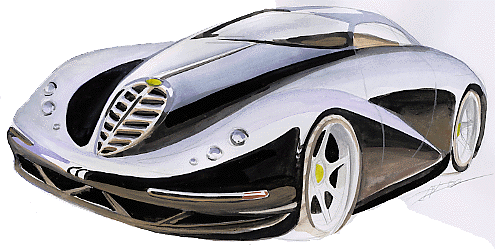
We could restrict ourselves to the Facel-Vega, however France possessed other gems in the thirties, gleaming machines still admired for the supremely baroque character of their line. We can mention five names of "GT" of this time, the Bugatti, Delahaye, Delage, Talbot, Hispano-Suiza. The Talbots had a late British revival under Peugeot, and lost in prestige, however, some studies of the immortal SS "teardrop" or Grand Sport are discussed below. Hispano-Suiza was recently taken over by Spain, and rightly so. Bugatti is in the bosom of VW. Remain Delahaye and Delage. These two brands were also closely intertwined in the 1930s, the Delage being very close to the Rebadged Delahaye after the takeover of this firm. The present study concerns the Delahaye 335. A fictitious model obviously, because the series ended with the 235. This model refers to the 135 model, fetish, emblem of the brand, essential luxury GT of this period with the Bugatti 57.
Genesis of Delahaye:
The goal here is not to go back over the history of this brand which was done in the pages of Gentleman-Driver.com. So let's sum up by quoting the famous meeting between Ettore Bugatti, the "Boss" of Molsheim and Charles Weiffenbach, the director of Delahaye, so far renowned for its solid trucks, like Pegaso in Spain. "Charles, your cars are excellent, but too heavy and too slow; Give them more speed and brilliance and they will once again enjoy great success." Two assets up its sleeve, an image of solidity, robustness and an image of reliability and power, that of its truck engines. However, a luxury GT cannot be improvised. In 1933, the year following this interview, the type 138 was released, with the 3.2 lite engine from one of his trucks. It's still more of a road car than a real GT. In 1934, the 138 was reviewed, with a short chassis and with its carburettors it increased to 100hp. She won the Alpine Cup in stride. The following 135 is lowered and its power increased. It is this model from 1935 that will win most of the events that count in France but also in Great Britain, an enviable record. The 135, according to its variations including the 135 M and MS, evolves into racing and road versions with up to three chassis lengths and a power of up to 235hp. But the 135, excellent and solid roadsters, are also unforgettable luxurious roadsters, whose chassis was the object of the greatest masterpieces of their time in the hands of the French bodywork school which then had primacy.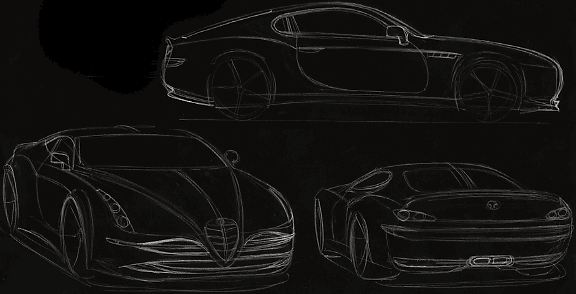 A Delahaye 345 coupé (with a V12)
A Delahaye 345 coupé (with a V12)
We will obviously mention the Chapron, Letourneur and Marchand, and of course Figoni and Falaschi, the "bodybuilders of kings", both their streamlined trim, abundant in very arts-deco chrome and high-grain leather, gold or crystal Baccara, have given them a nobility that is still worth it in the Californian Concours d'Elegance where these Delahaye 135s, always highly prized by collectors who lovingly restore them, remain the unmissable stars, machines escaped from Tex Avery's cartoons, and found on this new world a respondent, among these people who have always had a taste for tinsel.
Rebirth Opportunity:
Just like Facel-Véga, Delahaye retains an intact prestige for connoisseurs. Its very French name evokes the nostalgia of this pre-war era, and the panache associated with it is worth that of Bugatti, which however offered the image of a brand of GTs much more biting on the sporting level. The 335 roadsters, if they were built, would be a counterpart to the Facel-Vega coupés, with an even more assertive retro image. To be compared with Bugatti, which however aims for the latter the primacy, the absolute domination in the field of GTs with hallucinating power figures and a rather curious marriage of the Bugatti style of the thirties with the design of a berlinetta with a central rear engine. . The Delahaye would be in another niche, that of front-engined convertibles.Technical issues:

As has already been said, this 335, succeeding the 235 but closer in spirit to a 135, will have to be a 2+2 convertible, either with an electric soft top or a rigid retractable roof, a solution which has many advantages. . Regarding the structure, aluminum seems more suitable than steel because of its lightness, and retains the image of a noble material. Polyester would be completely out of place on a GT of this caliber. Regarding the engine, If the 145 had a V12, the 135 mentioned here had a V6. The question is whether there is a suitable French engine. The solution of creating a large displacement V6 being excluded for problems of cost, remains the V6 solution of one of our generalists. The V6 Peugeot/Citroën develops 210hp for 3 liters, and the Renault-Nissan, 3.5L and 245hp. these are insufficient working bases. Quite simply because the 335 cannot be a "small" GT, but neither is it a car less spacious than a Mercedes or a Bentley, because offering only two extra seats, its status imposes dimensions close to 4800x1900x1300 mm, for an estimated empty weight of 1400 Kgs.
A "beautiful baby" which cannot be satisfied with 245 hp. In the state it is therefore impossible to place the Renault-Nissan under its hood, notwithstanding the image that the presence of a Japanese engine under the hood would have on customers, especially in the USA, and of course for lack of power. The Delahaye is not classified in racing machines but in GTs halfway between the road spirit and frankly sporting, its services should therefore not be exaggerated, of the order of 0-100 Km/h crossed in 5.4 seconds for 280 Km/h or limited to 250, would be welcome. In this case, there are only two possibilities: Develop the Renault-Nissan, or choose a very powerful V6 outside France. In this case, BMW, Audi and Mercedes are able to have interesting ones. At Audi, there is the 2.7L of 250 hp, at BMW, it is of course the 343 hp V6 of the M3 which is preferable, but the M3 is noticeably more slender than the Delahaye.
On balance, the best solution is still to use a French biturbo V6 pushed to its limits: The Venturi 400 GT for the record, developed 408 hp starting from the venerable PRV block of the 300 Atlantique. But this last engine was intended for competition. Comfort was not his forte. The displacement increased to 4.5 liters would thus be a good start.
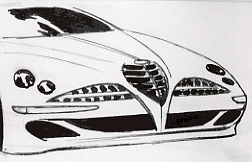
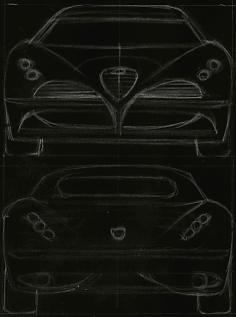

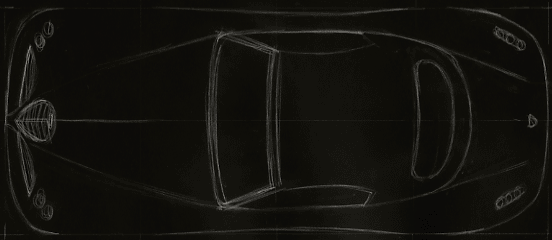
Design Matters:
The Delahaye 335 must be a concentrate of revisited 1930s style. There are two ways to achieve this: resort to a frenzied neo-retro style in order to facilitate immediate identification, or proceed to a fictional evolution, pretending that the Delahaye 235 had evolved in the 60s ( with the classic elegance of the Italian GTs), 70 (angular in the Bertonian fashion), 80 (angular again and very "tidy" perhaps bordering on anonymity), 90 (with a bio-design recalling good memories of its old curves), or 2000 (with an angular and energizing Edge Design). Follow fashions. This fiction also gives a set of styles that deserves the detour and that will be explored soon.The main difficulty in the first case consists in finding the Delahaye "style" at a time when the latter was above all that of the many coachbuilders who worked above all to give themselves the best image. Even its grille had more or less supported variants. However, what emerges from the study of most of the models is that this central element personalizing the grille, was most of the time of triangular shape in ogive, or in medieval shield, point downwards, which does not is reminiscent of that of Alfa-Romeo, the main difficulty from that moment being not to recall it. The grille of the 235, designed by Chapron, resembled much more with its wide oval, than that of contemporary sports cars. However, we have seen a more willing recourse to retro design since the mid-1990s, after the almost generalized anonymity of brands during the sad 1980s, towards a return to style singularities, the recovery of enhancing elements from the past of Mark. Like Alfa or Jaguar, the Delahaye would have followed this track, and would present a pointed grille, slightly different from that of the Alfa, more angular, but so that the mistake does not occur, the choice most judicious would be to use an element found on the Ghia-Aigle as well as on some other models, side opening gills, "moustaches", framing this grille. Treated in this original form, the Delahaye would become immediately identifiable.

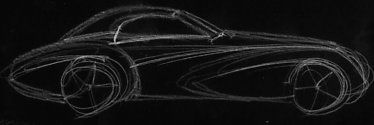

As for the profile of the line, the choice of a front engine dictates the classic canons in force in this area, a short, stocky front overhang, and a more or less elusive long rear, more in the case of Delahaye. Two interesting references not to be overlooked in terms of 1930s neo-retro style, the Morgan Aero 8, and the Wiesmann MF3. Both show that you can produce a sloping rear end without worrying too much about the consequences for handling due to the supposed lack of downforce in this area. Nothing would also prohibit integrating a removable spoiler, like the Porsche 911. As for the sides, should we reproduce the curve of the cambers of separate wheels or should we integrate everything into a monovolume? I lean towards the second solution, savoring more the purity of the sides and the massiveness tinged with solidity that emerges from a so-called reassuring model.

